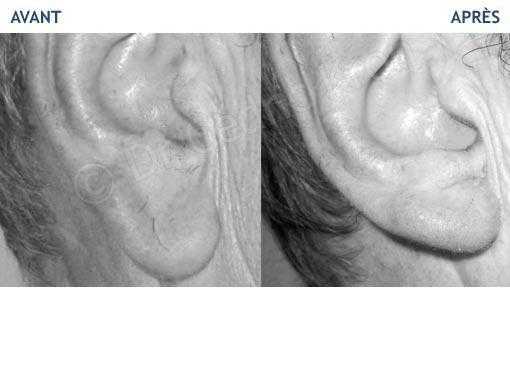The earlobe is the lower part of the auricle. It is made of adipose tissue and does not contain any cartilage. The lobe is a particularly delicate and vulnerable part of the ear. Its delicate and fragile skin does not benefit from cartilage support – unlike other parts of the outer ear.
Earlobe surgery is an aesthetic and/or restorative procedure recommended to people who are bothered by the appearance of their lobes (too big, split, torn, stretched). Earlobe restorative surgery is also recommended to patients who have experienced lobe tearing (due to an accident) or lengthening of the lobe as the result of wearing heavy ear loops or ear retractors.
Surgery of split or torn lobes
In many cultures, earlobes have been a preferred area of the body to wear jewelry. Wearing earrings or piercings to the ear usually involves a perforation of the lobes.
Certain circumstances can lead to an injury of the earlobe: wearing heavy earrings that gradually stretch the lobe or tearing after an accident.
Repairing an ear lobe after an accident
Split earlobe surgery is an aesthetic and restorative surgical procedure for people with "torn" lobes. A lobe tear can be caused by an accident while wearing hearings. The lobes can also tear after the prolonged usage of heavy jewels that widened the pierced hole over time, ending up splitting the lobe.
When to proceed with an earlobe surgery?
Surgical correction of split lobes can only happen after complete healing of the tear.
The procedure involves removing part of the skin of the lobe and then performing a suture. At the end of the procedure, lobes are remodeled and the initial harmony of the ear is visible again.
Stretched lobe surgery
Stretched lobe surgery is intended for people who find their lobes too long, especially after wearing heavy earrings that have deformed the lobe over time. It is also aimed at people who have worn ear tapers or stretchers and want to get their lobes back to their regular size.
Earlobes are subject to gravity. This part of the body actually stretches with aging - stretching happens with the progressive loss of fat in lobes as years pass by. Stretched lobe surgery can also serve the purpose of overall face rejuvenation.
Stretched lobe correction is a relatively simple ear surgery as lobes are made up of skin and adipose tissue and not cartilage.
Principles of earlobe surgery
The main goal of earlobe surgery is to reshape the lobe to give it more harmonious proportions.
After severing the lower part of the stretched earlobe, a simple suture is performed. Depending on the type of tear, the suture shape may vary to optimize healing and make the scar as little visible as possible.
In some cases, hyaluronic acid or fat injections (lipostructure) are used as a complement to rejuvenate the firmness of the earlobe, thus plumping a lobe having lost its volume and its tonicity.
The procedure for correcting stretched ear lobes takes 45 minutes on average. Surgery is usually performed under local anesthesia.
Operative follow-up of an earlobe correction
After the procedure
Postoperative pain is generally weak and can be soothened using simple analgesics (without prescription). Just like with any other surgery procedure, it is normal to notice a small edema (swelling) and bruising (blue) in the treated area. These disappear gradually during the days following the procedure.
Threads are removed after 8 to 10 days if they do not resolve spontaneously.
Results of earlobe surgery
The final result of stretched or torn earlobe surgery can be assessed after 3 months.
The ears can be pierced again from the 6th month following the intervention.
Before & After: Earlobe surgical correction

> See Before - After photos of earlobe surgery
Note: Earlobe surgery does not treat what is commonly known as "dumbo ears" (protruding ears). To treat this malformation of the ear, one must consider otoplasty.
Smoking increases the risks of surgical complications of any surgery**. Quitting smoking 6-8 weeks before the procedure eliminates any additional risks. If you smoke, talk to your doctor or call Tabac-Info-Service at 3989 to help reduce risks of plastic surgery procedures.